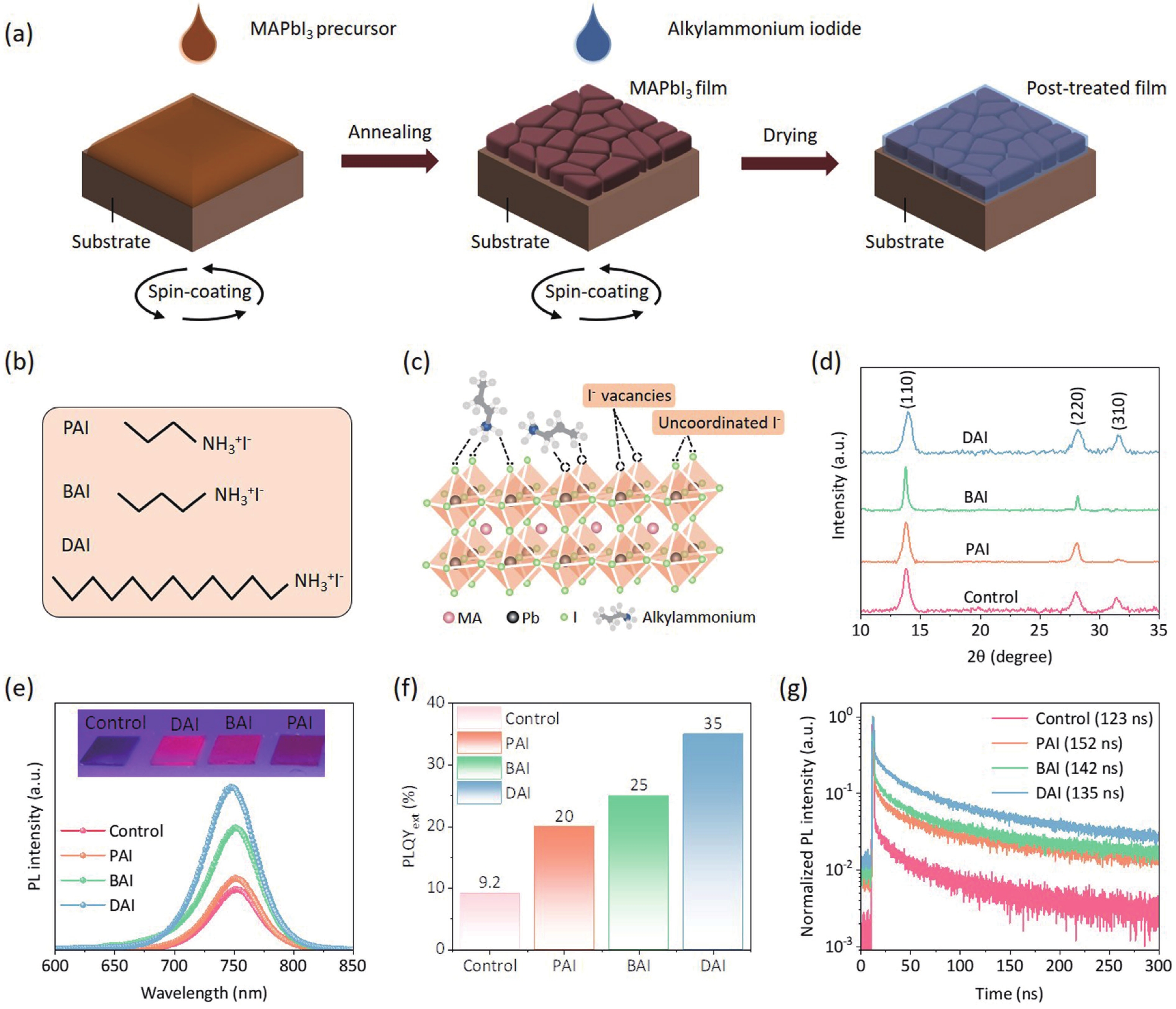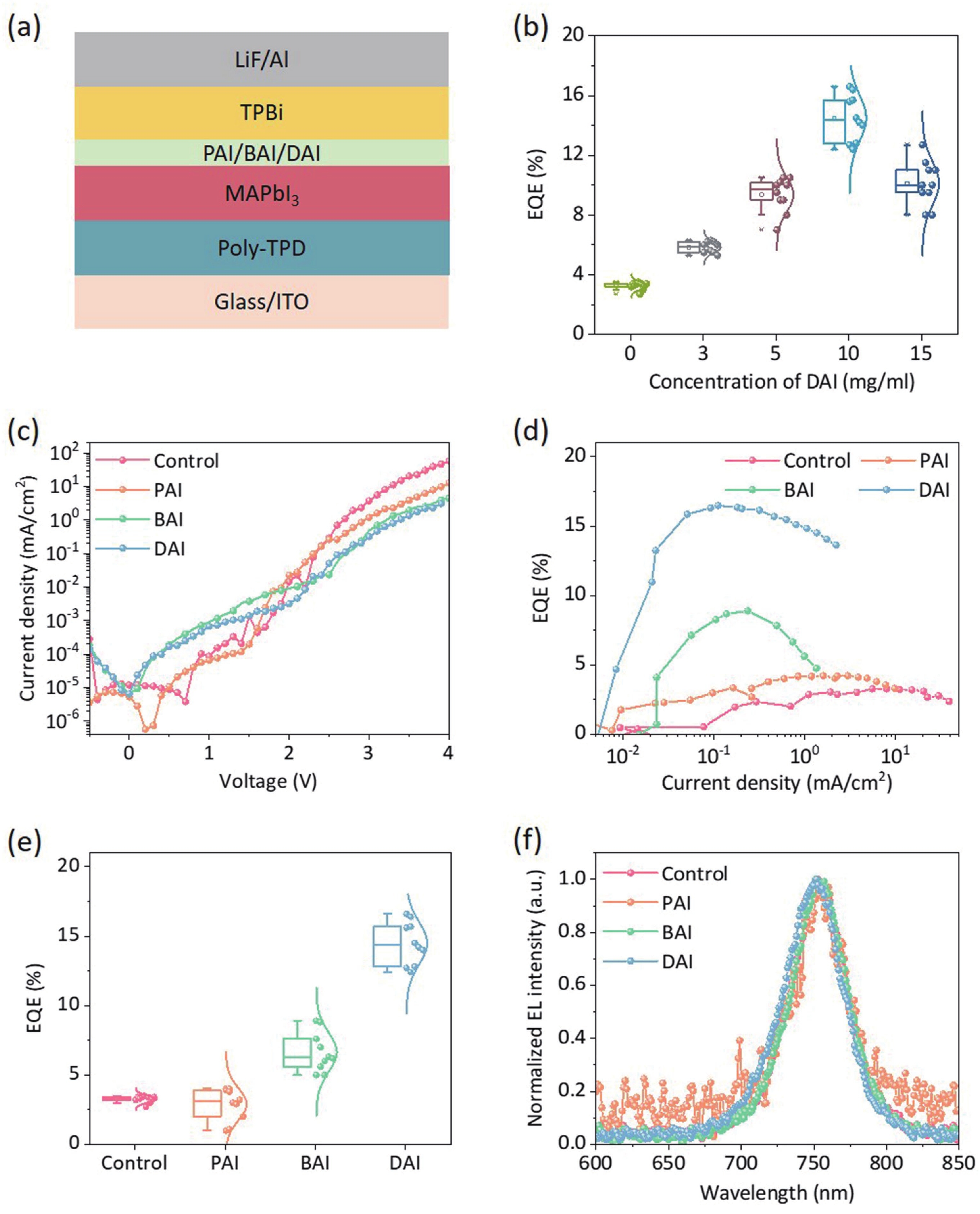| Citation: |
Rashid Khan, Guangyi Shi, Wenjing Chen, Zhengguo Xiao, Liming Ding. Interface engineering yields efficient perovskite light-emitting diodes[J]. Journal of Semiconductors, 2023, 44(12): 120501. doi: 10.1088/1674-4926/44/12/120501
****
R Khan, G Y Shi, W J Chen, Z G Xiao, L M Ding. Interface engineering yields efficient perovskite light-emitting diodes[J]. J. Semicond, 2023, 44(12): 120501. doi: 10.1088/1674-4926/44/12/120501
|
Interface engineering yields efficient perovskite light-emitting diodes
DOI: 10.1088/1674-4926/44/12/120501
More Information
-
References
[1] Kojima A, Teshima K, Shirai Y, et al. Organometal halide perovskites as visible-light sensitizers for photovoltaic cells. J Am Chem Soc, 2009, 131, 6050 doi: 10.1021/ja809598r[2] Green M A, Ho-Baillie A, Snaith H J. The emergence of perovskite solar cells. Nat Photonics, 2014, 8, 506 doi: 10.1038/nphoton.2014.134[3] Xiao Z G, Yuan Y B, Wang Q, et al. Thin-film semiconductor perspective of organometal trihalide perovskite materials for high-efficiency solar cells. Mater Sci Eng R Rep, 2016, 101, 1 doi: 10.1016/j.mser.2015.12.002[4] Min H, Lee D Y, Kim J, et al. Perovskite solar cells with atomically coherent interlayers on SnO2 electrodes. Nature, 2021, 598, 444 doi: 10.1038/s41586-021-03964-8[5] Zhang S, Ye F Y, Wang X Y, et al. Minimizing buried interfacial defects for efficient inverted perovskite solar cells. Science, 2023, 380, 404 doi: 10.1126/science.adg3755[6] Tan Z K, Moghaddam R S, Lai M L, et al. Bright light-emitting diodes based on organometal halide perovskite. Nat Nanotechnol, 2014, 9, 687 doi: 10.1038/nnano.2014.149[7] Xiao Z G, Kerner R A, Zhao L F, et al. Efficient perovskite light-emitting diodes featuring nanometre-sized crystallites. Nat Photonics, 2017, 11, 108 doi: 10.1038/nphoton.2016.269[8] Chen J, Ma P C, Chen W J, et al. Overcoming outcoupling limit in perovskite light-emitting diodes with enhanced photon recycling. Nano Lett, 2021, 21, 8426 doi: 10.1021/acs.nanolett.1c03035[9] Cheng G Q, Liu Y, Chen T, et al. Efficient all-inorganic perovskite light-emitting diodes with improved operation stability. ACS Appl Mater Interfaces, 2020, 12, 18084 doi: 10.1021/acsami.9b23170[10] Ye D, Li Z J, Chen W J, et al. Stable yellow light-emitting diodes based on quasi-two-dimensional perovskites. ACS Appl Mater Interfaces, 2022, 14, 34918 doi: 10.1021/acsami.2c07314[11] Liu X K, Xu W D, Bai S, et al. Metal halide perovskites for light-emitting diodes. Nat Mater, 2021, 20, 10 doi: 10.1038/s41563-020-0784-7[12] Khan R, Chu S L, Li Z J, et al. High radiance of perovskite light-emitting diodes enabled by perovskite heterojunctions. Adv Funct Mater, 2022, 32, 2203650 doi: 10.1002/adfm.202203650[13] Dou L T, Yang Y, You J B, et al. Solution-processed hybrid perovskite photodetectors with high detectivity. Nat Commun, 2014, 5, 5404 doi: 10.1038/ncomms6404[14] Yakunin S, Sytnyk M, Kriegner D, et al. Detection of X-ray photons by solution-processed lead halide perovskites. Nat Photonics, 2015, 9, 444 doi: 10.1038/nphoton.2015.82[15] Wei H T, Fang Y J, Mulligan P, et al. Sensitive X-ray detectors made of methylammonium lead tribromide perovskite single crystals. Nat Photonics, 2016, 10, 333 doi: 10.1038/nphoton.2016.41[16] Chen Q S, Wu J, Ou X Y, et al. All-inorganic perovskite nanocrystal scintillators. Nature, 2018, 561, 88 doi: 10.1038/s41586-018-0451-1[17] Xiao Z G, Yuan Y B, Shao Y C, et al. Giant switchable photovoltaic effect in organometal trihalide perovskite devices. Nat Mater, 2015, 14, 193 doi: 10.1038/nmat4150[18] Xiao Z G, Huang J S. J Energy-efficient hybrid perovskite memristors and synaptic devices. Adv Electron Mater, 2016, 2, 1600100 doi: 10.1002/aelm.201600100[19] Fang Z, Chen W, Shi Y, et al. Dual passivation of perovskite defects for light-emitting diodes with external quantum efficiency exceeding 20%. Adv Funct Mater, 2020, 30, 1909754 doi: 10.1002/adfm.201909754[20] D’Innocenzo V, Srimath Kandada A R, De Bastiani M, et al. Tuning the light emission properties by band gap engineering in hybrid lead halide perovskite. J Am Chem Soc, 2014, 136, 17730 doi: 10.1021/ja511198f[21] Liu Z, Qiu W D, Peng X M, et al. Perovskite light-emitting diodes with EQE exceeding 28% through a synergetic dual-additive strategy for defect passivation and nanostructure regulation. Adv Mater, 2021, 33, 2103268 doi: 10.1002/adma.202103268[22] Kim J S, Heo J M, Park G S, et al. Ultra-bright, efficient and stable perovskite light-emitting diodes. Nature, 2022, 611, 688 doi: 10.1038/s41586-022-05304-w[23] Bai W H, Xuan T T, Zhao H Y, et al. Perovskite light-emitting diodes with an external quantum efficiency exceeding 30%. Adv Mater, 2023, 35, 2302283 doi: 10.1002/adma.202302283[24] Guo Y W, Apergi S, Li N, et al. Phenylalkylammonium passivation enables perovskite light emitting diodes with record high-radiance operational lifetime: The chain length matters. Nat Commun, 2021, 12, 644 doi: 10.1038/s41467-021-20970-6[25] Kim H, Lee S U, Lee D Y, et al. Optimal interfacial engineering with different length of alkylammonium halide for efficient and stable perovskite solar cells. Adv Energy Mater, 2019, 9, 1902740 doi: 10.1002/aenm.201902740[26] Ye X F, Cai H K, Sun Q H, et al. Alkyl ammonium salt with different chain length for high-efficiency and good-stability 2D/3D hybrid perovskite solar cells. Org Electron, 2022, 106, 106542 doi: 10.1016/j.orgel.2022.106542[27] Feng W H, Zhang C X, Zhong J X, et al. Correlating alkyl chain length with defect passivation efficacy in perovskite solar cells. Chem Comm, 2020, 56, 5006 doi: 10.1039/D0CC01197E[28] Zhao P J, Subbiah J, Zhang B L, et al. Alkyl chain length-dependent amine-induced crystallization for efficient interface passivation of perovskite solar cells. Adv Mater Interfaces, 2023, 10, 2202313 doi: 10.1002/admi.202202313[29] Na H, Meng Q L, Cha J, et al. Passivating detrimental grain boundaries in perovskite films with strongly interacting polymer for achieving high-efficiency and stable perovskite solar cells. Appl Surf Sci, 2023, 626, 157209 doi: 10.1016/j.apsusc.2023.157209[30] Wang F, Bai S, Tress W, et al. Defects engineering for high-performance perovskite solar cells. NPJ Flex Electron, 2018, 2, 22 doi: 10.1038/s41528-018-0035-z[31] Sherkar T S, Momblona C, Gil-Escrig L, et al. Recombination in perovskite solar cells: Significance of grain boundaries, interface traps, and defect ions. ACS Energy Lett, 2017, 2, 1214 doi: 10.1021/acsenergylett.7b00236[32] Shen X Y, Kang K, Yu Z K, et al. Passivation strategies for mitigating defect challenges in halide perovskite light-emitting diodes. Joule, 2023, 7, 272 doi: 10.1016/j.joule.2023.01.008[33] Liu Z, Meng K, Wang X, et al. In situ observation of vapor-assisted 2D-3D heterostructure formation for stable and efficient perovskite solar cells. Nano Lett, 2020, 20, 1296 doi: 10.1021/acs.nanolett.9b04759[34] Shao Y C, Xiao Z G, Bi C, et al. Origin and elimination of photocurrent hysteresis by fullerene passivation in CH3NH3PbI3 planar heterojunction solar cells. Nat Commun, 2014, 5, 5784 doi: 10.1038/ncomms6784[35] Kore B P, Zhang W, Hoogendoorn B W, et al. Moisture tolerant solar cells by encapsulating 3D perovskite with long-chain alkylammonium cation-based 2D perovskite. Commun Mater, 2021, 2, 100 doi: 10.1038/s43246-021-00200-8 -
Supplements
 23100019.docx
23100019.docx

-
Proportional views






 DownLoad:
DownLoad:











 Rashid Khan is currently a PhD student at the Department of Physics, University of Science and Technology of China (USTC). He obtained his MS degree from the International Islamic University Islamabad, Pakistan in 2016. His current research focuses on the interface engineering of perovskite LEDs
Rashid Khan is currently a PhD student at the Department of Physics, University of Science and Technology of China (USTC). He obtained his MS degree from the International Islamic University Islamabad, Pakistan in 2016. His current research focuses on the interface engineering of perovskite LEDs Guangyi Shi got his BS degree from Soochow University in 2021. Now he is a Master student at the University of Science and Technology of China under the supervision of Prof. Zhengguo Xiao. His current research focuses on large-area perovskite LEDs
Guangyi Shi got his BS degree from Soochow University in 2021. Now he is a Master student at the University of Science and Technology of China under the supervision of Prof. Zhengguo Xiao. His current research focuses on large-area perovskite LEDs Wenjing Chen got her PhD from Department of Physics, University of Science and Technology of China (USTC) in 2022. Now she is a postdoc at USTC. Her research focuses on perovskite materials and devices
Wenjing Chen got her PhD from Department of Physics, University of Science and Technology of China (USTC) in 2022. Now she is a postdoc at USTC. Her research focuses on perovskite materials and devices Zhengguo Xiao got his PhD from University of Nebraska-Lncoln in 2015. After 3-years postdoc at Princeton University, he joined Department of Physics, University of Science and Technology of China, as a professor. His research focuses on perovskite LEDs, solar cells, and detectors
Zhengguo Xiao got his PhD from University of Nebraska-Lncoln in 2015. After 3-years postdoc at Princeton University, he joined Department of Physics, University of Science and Technology of China, as a professor. His research focuses on perovskite LEDs, solar cells, and detectors Liming Ding got his PhD from University of Science and Technology of China (was a joint student at Changchun Institute of Applied Chemistry, CAS). He started his research on OSCs and PLEDs in Olle Inganäs Lab in 1998. Later on, he worked at National Center for Polymer Research, Wright-Patterson Air Force Base and Argonne National Lab (USA). He joined Konarka as a Senior Scientist in 2008. In 2010, he joined National Center for Nanoscience and Technology as a full professor. His research focuses on innovative materials and devices. He is RSC Fellow, and the Associate Editor for Journal of Semiconductors
Liming Ding got his PhD from University of Science and Technology of China (was a joint student at Changchun Institute of Applied Chemistry, CAS). He started his research on OSCs and PLEDs in Olle Inganäs Lab in 1998. Later on, he worked at National Center for Polymer Research, Wright-Patterson Air Force Base and Argonne National Lab (USA). He joined Konarka as a Senior Scientist in 2008. In 2010, he joined National Center for Nanoscience and Technology as a full professor. His research focuses on innovative materials and devices. He is RSC Fellow, and the Associate Editor for Journal of Semiconductors





